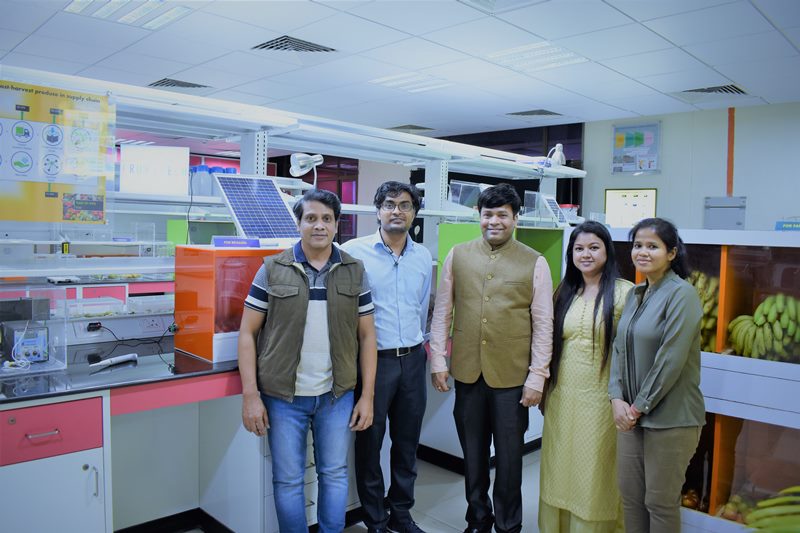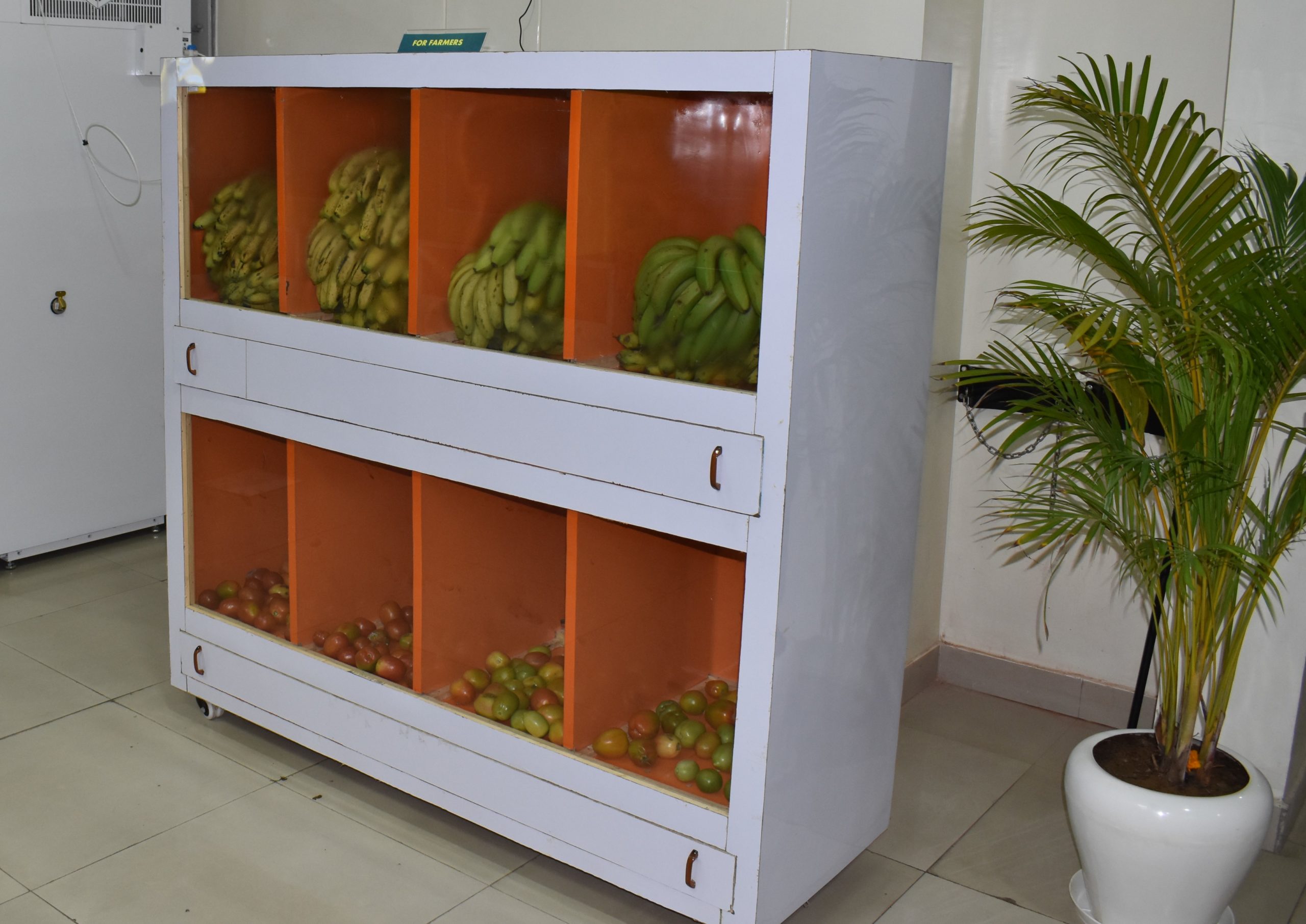An innovative device that enhances the shelf life of fruits and vegetables, and promises to boost farmers’ income
A new energy efficient and cheap device developed by Indian scientists can address the problem of postharvest losses in India. This device increases the shelf life of fruits and vegetables, and unlike the cold storage units that are affected by power cuts, this new device can function on solar energy.


Papayas kept in the device without formula (left) and with formula (right). All photos: Jagadis Gupta Kapuganti.
About 30 per cent of fruits and vegetables grown in India, which amounts to 40 million tonnes and costs over Rs 965.39 billion, annually get wasted, points out the International Society for Horticultural Science, the world’s leading independent organisation of horticultural scientists. This is primarily due to the lack of proper storage facilities and transportation chain to protect the produce from rotting.
To address this problem, Indian scientists have come up with a first-of-its-kind innovation to enhance the shelf life of fruits and vegetables. It is an energy efficient and cheaper alternative to cold storage, developed specifically for the use by farmers.
Known as ‘shelf life enhancer’, this device is expected to reduce post harvest losses in storage, transportation, and distribution chains in the country.
Explaining the functioning of the device, Jagadis Gupta Kapuganti, scientist, National Institute of Plant Genome Research, which has come up with this innovation, said: “The loss of fruits and vegetables is due to overripening of the produce, which is accompanied by enhanced levels of ethylene. Ethylene, a gaseous component, causes the ripening of fruits and vegetables.”
“To address this problem, we have developed a formula (which is put inside the device) that can generate very low amounts of nitric oxide made from natural resources. Nitric oxide is an inhibitor of ethylene”, Kapuganti explained to Gaon Connection. He heads the team that has been working on the innovation for the past two years. “Simply put, the shelf life enhancer delays the ripening of fruits and vegetables thereby enhancing their shelf life,” he added.
The benefits are immense. For instance, by using the device, the shelf life of bananas and tomatoes gets enhanced by a week, chikoos (Sapodilla) by two weeks, and shareefa (sugar-apple) by two-three days. Generally these fruits and vegetables can be stored only for two-three days.

The scientist informed that as of now the team is looking for the trademark for the device to give it a formal name. For now, the researchers have named the device as ‘shelf life enhancer’. Kapuganti applied several national and international patents for this technology. He got funding from Biotechnology Industry Research Assistance Council (BIRAC)-via Biotechnology Ignition Grant.
Post harvest losses in India
According to the 2018 article published in Journal of Agricultural Science and Food Research, India wastes more fruits and vegetables than it consumes. Enough attention has been paid at the pre-harvest stage for boosting the levels of production by techniques like crop rotation, soil conservation, pest control, fertilisers, irrigation. But, postharvest issues have not been addressed adequately.
These postharvest losses can be attributed to inadequate storage facilities, gaps in the cold chain such as poor infrastructure, insufficient cold storage capacity, unavailability of cold storages in close proximity to farms, and poor transportation infrastructure.
Owing to the limited shelf life of fruits and vegetables, farmers growing horticultural crops suffer major setbacks. The lack of access to cold storage infrastructure and refrigerated vehicles forces them to sell their produce at low prices resulting in farmer frustrations and sometimes in farmer suicides.
Thus, despite having achieved national food security, the well-being of over 200 million Indian farmers and farm workers, who are the backbone of Indian agriculture, continues to be a matter of grave concern.
Also Read: Poultry farmers refurbish junk refrigerators as hatcheries

How does the shelf life enhancer work?
The device uses postharvest application of nitric oxide to reduce post-harvest losses of fruits and vegetables during storage, transportation and distribution.
“We have two chambers, one is smaller and the other is a bigger chamber. In the smaller chamber, we keep the formula, from where nitric oxide is slowly released into the bigger chamber. Fruits and vegetables are stored in the bigger chamber,” informed Kapuganti.
“This formula releases nitric oxide in very low quantities. It is the first-of-its-kind innovation in the world,” he added.
Nitric oxide acts as a multifunctional signaling molecule in various plant physiological processes such as fruit ripening and senescence of fruits and vegetables. Exogenous application of nitric oxide has been demonstrated beneficial to reduce the production of ethylene and reduce rate of respiration, according to the Journal of Agricultural Science and Food Research.
Kapuganti informed that the successful application of nitric oxide has been tested for custard apple, sharifa, banana, chikoo, mango, pear, plum, papaya and vegetables such as tomatoes and broccoli. This is done by inhibiting the action of ethylene hence improving the shelf life of fruits and vegetables.
Also Read: Traditional polyhouses get a makeover with retractable roofs

Using energy-efficient solutions
The scientists at National Institute of Plant Genome Research, an autonomous institution under the Department of Biotechnology of the Government of India, have used wood, polyacrylic material to make the device for storing the produce for a longer duration.
One of the major problems with cold storage is that it is dependent on an unreliable power supply. Indian cold storages mostly depend on grid electricity. As a result, an unreliable power supply in rural India, rising costs of electricity and dependence on conventional fuels limit operations, expansion and decentralisation of the cold storage industry.
To address this, the researchers have designed the device using thermoelectric coolers as well as solar panels.
“Using the device, fruits can also be kept for several days in farms as the solar panels ensure to maintain temperature between 25 to 27 degrees Celsius. It is normal temperature, not too high like heat in summers in fields,” informed Kapuganti. “We also have thermal electric coolers in the devices so that there is no failure of power and produce can be stored for a longer duration until it is transported,” he said.

Additional advantages
“Besides enhancing the shelf life, we found that the treated fruits have higher levels of nutrients and minerals. It also prevents spoilage of fruits and vegetables such as mushrooms. Nitric oxide increases disease resistance,” claimed the scientist.
Therefore, the device ensures that freshness is maintained, storage for longer duration, enhances nutrients and reduces spoilage of fruits by microorganisms.
Also Read: ‘Rice and wheat in India are lot less nutritious than they were 50 years ago’

Cheaper alternative to cold storages
The device has been specifically developed for the use of farmers, retailers, and consumers. “Our device is extremely cheap. There are two kinds of devices we are making, one is with thermal electric coolers and other with solar panels. Price varies based on the material we use. It varies from Rs 1,500 to Rs 5,000,” said Kapuganti.
The device is claimed to be a one time investment for farmers, who would not need to buy it again and again. The formula used is estimated to cost one rupee per kilo to the farmers. The researchers are also using recycled plastic instead of virgin plastic in order to reduce the threat to the environment.
Kapuganti informed that the team is in stages of scaling up the innovation technology so that they can take it to the farm level.
“We want to raise funding for large scale trials. Right now we are in the process of contacting for technology transfer. We will give non-exclusive licence to the device makers and then the device can hit the market,” he said.
Also Read: Portable polyhouse puts the smile back on faces of marginal farmers in the hills

